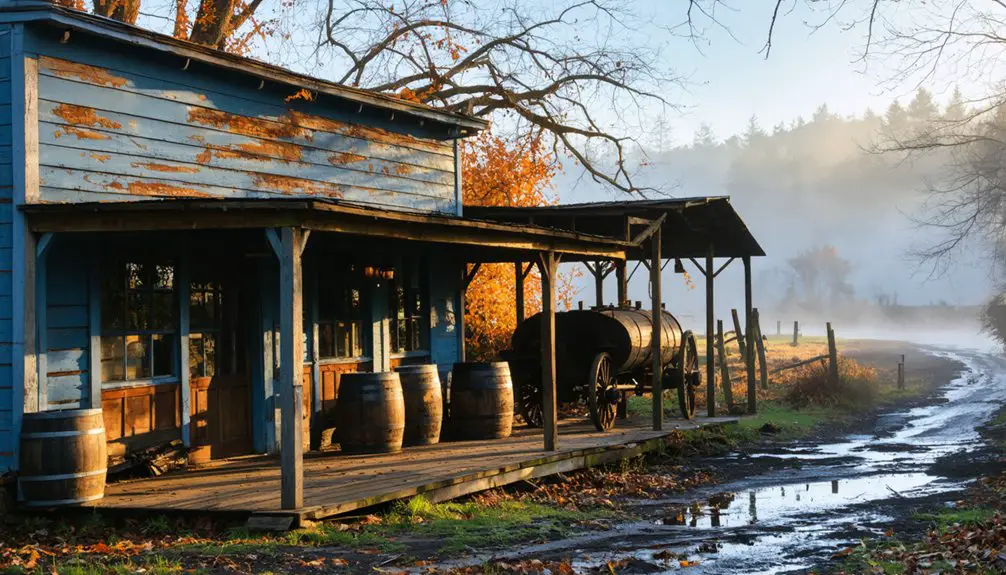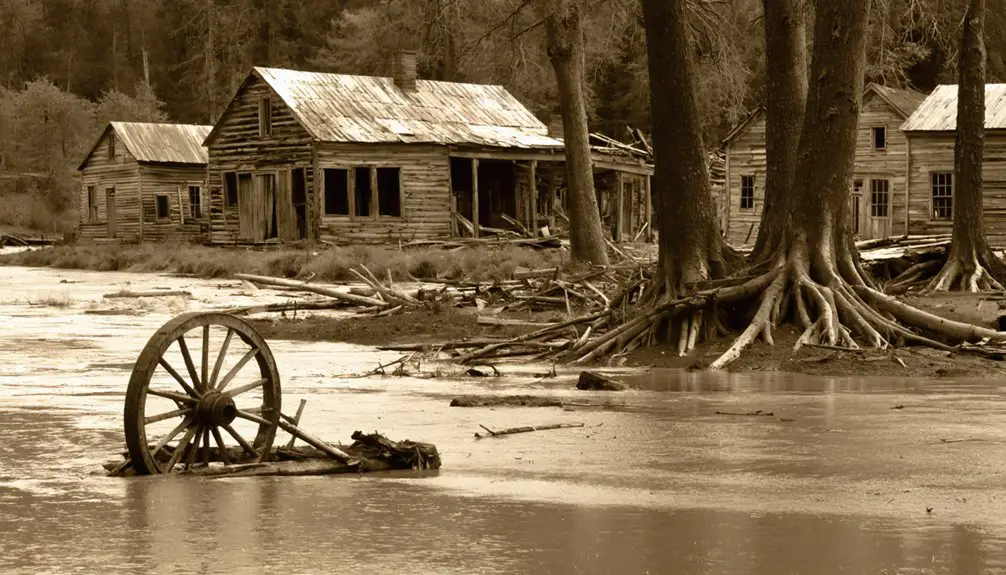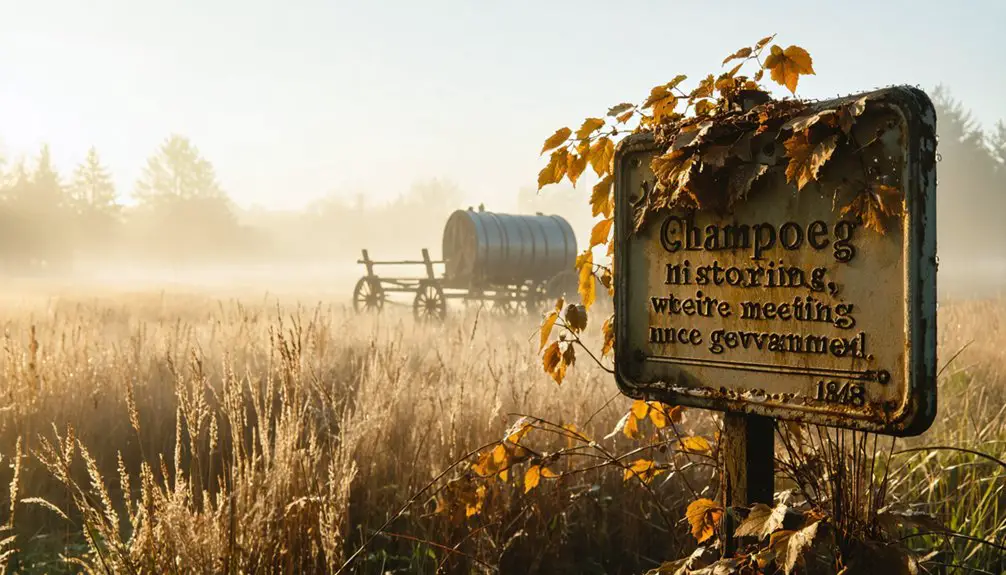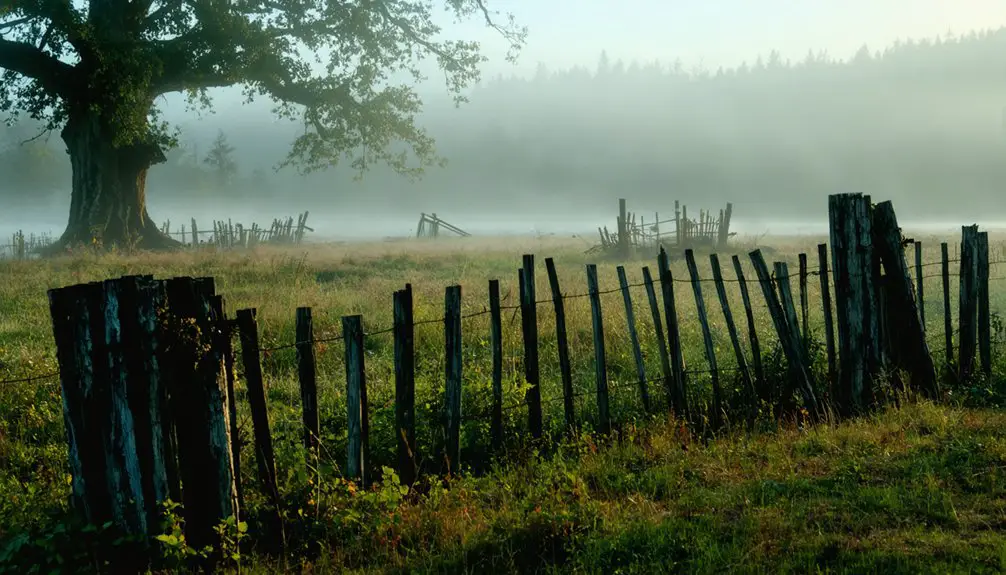You’ll find Champoeg’s ghost town remnants along Oregon’s Willamette River, where a bustling pioneer settlement once thrived in the 1840s. The town played a pivotal role in Oregon’s statehood through the historic 1843 vote that established the territory’s first provisional government. Two devastating floods – one in 1861 and another in 1890 – submerged the town under 30 feet of water, forcing its abandonment. Today’s Champoeg State Heritage Area preserves this remarkable chapter of Pacific Northwest history.
Key Takeaways
- Champoeg was a thriving riverside town with 60 buildings and 200 residents before devastating floods led to its abandonment.
- The Great Flood of 1861 destroyed most structures, with water levels reaching 30 feet above normal.
- A second catastrophic flood in 1890 submerged Champoeg under 23-30 feet of water, leading to its permanent abandonment.
- Residents relocated to nearby Butteville after the floods, leaving Champoeg to become a ghost town.
- Today, Champoeg exists as a State Heritage Area with six preserved historic buildings and archaeological excavations.
The Birth of a Pioneer Settlement
When Robert Newell purchased farmland from Walter Pomeroy in the early 1840s, he set in motion the founding of what would become Champoeg.
You’ll find that early settlers like André Longtain had already been farming the adjacent land since the 1830s, with Jesse Applegate surveying both properties in 1844.
Newell and Longtain didn’t waste time – they began selling town lots that same year, well before the formal town plat was filed in 1853.
The ambitious founders wasted no time developing Champoeg, selling plots years before officially registering the town in 1853.
The Hudson’s Bay Company had established a warehouse in 1843 for storing wheat from local farmers.
As one of several ambitious settlements along the Willamette River, Champoeg faced community challenges head-on.
The historic first provisional government of the Oregon Country was established here in 1843, marking a pivotal moment in Oregon’s history.
The town grew steadily through the 1850s, and you’d have found about 60 buildings housing roughly 200 residents by decade’s end, making it a notable competitor to emerging settlements like Portland and Oregon City.
From Native Lands to French-Canadian Trading Post
You’ll find the Kalapuya people‘s early presence at Champoeg deeply intertwined with the Willamette River, where they established transportation routes and sustained themselves through hunting and fishing.
By 1811, French-Canadian fur trappers working for the Hudson’s Bay Company began operating in the area, gradually transforming the Native trading intersection into a permanent settlement. Cultural exchanges flourished as retired fur traders married into local tribes, creating lasting bonds between communities. A significant moment occurred when fifty-two settlers voted to establish Oregon’s first provisional government in 1843.
The Hudson’s Bay Company’s construction of a granary and trade store in 1843 cemented Champoeg’s evolution into a significant commercial hub, bridging Native American and Euro-American economic interests.
Early Kalapuya River Life
Long before French-Canadian traders arrived, the Kalapuya people thrived along the Willamette Valley‘s intricate river systems, establishing permanent villages near tributaries and foothills.
You’d find their settlements strategically positioned to access essential river resources, with distinct bands like the Santiam Kalapuya controlling specific territories along the waterways.
These resourceful inhabitants mastered their environment through seasonal movements between fishing camps and permanent villages.
Women gathered nuts, berries, and roots from rich floodplains, while men hunted and fished using tools crafted from nearby volcanic materials.
They’d maintain their territories through three main linguistic groups – north, central, and south – each adapting to their specific river valleys.
Through controlled burning and sophisticated fishing techniques, the Kalapuya created a sustainable lifestyle deeply connected to the region’s waterways.
Before European contact, an estimated 15,000 tribal members inhabited these lands, though their population would later be devastated by disease epidemics.
The tribes practiced careful land stewardship through annual burning practices that cleared vegetation and renewed their vital food sources.
French Traders Establish Settlement
As the Hudson’s Bay Company expanded its fur trading operations into the Willamette Valley in 1811, French-Canadian trappers established initial contact with the Kalapuya people at what would become Champoeg.
You’ll find that this strategic location, where riverbank met prairie, quickly became a crucial hub for cultural exchange between Native peoples and European traders.
By 1825, Fort Vancouver‘s establishment strengthened the fur trade network, while HBC Chief Factor John McLoughlin encouraged retired French-Canadian trappers to settle permanently.
These settlers transformed from fur traders to farmers in the 1830s, receiving agricultural supplies from the HBC.
The Kalapuya had inhabited and managed the land for at least 8,000 years, maintaining the prairie through controlled burns before European settlement began.
By 1843, they’d built a warehouse at Champoeg to store wheat and other goods, with annual harvests exceeding 10,000 bushels.
The trading post became central to the region’s emerging agricultural economy, linking Native trading routes with new settler commerce.
The area’s importance grew significantly when settlers gathered for the historic Champoeg vote that would determine Oregon’s provisional government.
Trading Post Growth Accelerates
The Kalapuya people’s ancient presence at Champoeg shaped its development into a vibrant trading hub long before European arrival.
You’ll find their legacy in the strategic trail intersections and river routes that later drew fur traders to this prime location.
The trading dynamics shifted dramatically after 1811 when the Pacific Fur Company, followed by the Hudson’s Bay Company, established operations here.
By 1825, French-Canadian trappers had integrated with native networks, while HBC’s warehouse construction in 1843 marked Champoeg’s evolution into a major agricultural exchange center.
You’ll see how this transformation created a unique economic ecosystem where wheat receipts served as currency, and steamboat arrivals connected local farmers to international markets.
This strategic position between Fort Vancouver and the Willamette Valley cemented Champoeg’s role as an essential commercial crossroads.
The Historic Vote That Changed Oregon
On May 2, 1843, settlers gathered at Champoeg in Oregon Country’s Willamette Valley to cast what would become one of the Pacific Northwest’s most pivotal votes.
You would’ve witnessed 102 settlers debating their future near a Hudson’s Bay Company warehouse along the Willamette River.
The Champoeg vote emerged from pressing governance challenges, including the need to manage estates, protect livestock, and establish law and order in the jointly-occupied territory.
The vote laid the groundwork for westward expansion before California’s famous gold rush began.
The final tally revealed a narrow margin with 52 votes for and 50 votes against establishing Oregon’s first provisional government.
Life in a Thriving River Town

Situated strategically along the Willamette River’s banks, Champoeg flourished as an essential commercial hub during the 1850s, boasting nearly 200 residents and 50 buildings.
You’d find pioneer commerce thriving through various establishments, including stores, a hotel, blacksmith, and saloons. The town’s river transportation infrastructure featured steamboat landings and a ferry crossing, connecting you to crucial trading routes.
Life centered around the Hudson’s Bay Company warehouse, where wheat from French Prairie farmers made its way downstream.
You could spend your leisure time at the bowling alley or attend services at the Episcopal church. The community’s diverse population of French-Canadian fur trappers and American settlers created a unique cultural blend, while the Butteville Academy provided education for the town’s youth.
The Great Flood of 1861
After eighteen consecutive days of relentless rain pounded the Willamette Valley in late 1861, Champoeg faced catastrophic destruction as floodwaters rose to unprecedented heights.
The flood impact devastated the once-thriving river town when water levels reached 30 feet in the bottomland, destroying nearly every structure except the Hudson’s Bay Company warehouse.
You’ll find these stark realities about Champoeg’s demise:
- Fast-moving currents filled with driftwood and massive fir logs washed away entire buildings
- Despite multiple dangerous evacuation trips, residents miraculously survived by fleeing to higher ground
- The economic decline was severe – land values plummeted from $500 to under $50 per acre
The town never recovered from this catastrophic event, marking the end of Champoeg’s prominence in the Willamette Valley.
Nature’s Final Blow: The 1890 Flood

While Champoeg’s residents hoped to rebuild following the devastating 1861 flood, nature delivered a final, crushing blow in 1890 when floodwaters again submerged the town under 23 to 30 feet of water.
This time, there’d be no flood recovery. The raging waters, fueled by heavy rains and melting snowpack, scoured away buildings and infrastructure, leaving only sand and bare soil behind.
You’ll find that property values plummeted from $500 to under $50 per acre, while one-third of Oregon’s cattle perished statewide. The community’s resilience finally broke, and residents permanently abandoned Champoeg, relocating to nearby Butteville.
They took what little remained, including the school bell, signaling the end of their once-thriving settlement. Unlike higher-elevation towns like Corvallis, Champoeg would never rise again.
Preserving a Lost Town’s Legacy
When you visit Champoeg State Heritage Area today, you’ll discover six preserved historic buildings, including Oregon’s oldest operating business, the Butteville Store, alongside archaeological excavations that have yielded over 9,000 artifacts from the lost pioneer town.
Through guided tours, living history demonstrations, and the Champoeg Promise educational program, you can experience firsthand how early settlers shaped Oregon’s territorial government.
The 662-acre park’s extensive trail system, visitor center exhibits, and regular commemorative events guarantee that while the original town may have washed away, its pivotal role in Oregon’s history remains alive and accessible.
Historical Site Restoration Projects
Through extensive restoration initiatives, Champoeg’s historical legacy continues to emerge from beneath decades of agricultural use.
You’ll find a thorough approach to preservation that combines restoration techniques with ecological impact studies, transforming formerly farmed lands into native prairie ecosystems that reflect the area’s historical character.
- Archaeological excavations have unearthed over 9,000 artifacts, revealing new insights into French-Canadian settler life and extending the settlement’s known timeline.
- Infrastructure improvements include upgraded visitor facilities, new bridges, and enhanced recreational areas that maintain historical authenticity.
- Prairie restoration efforts integrate traditional ecological knowledge through partnerships with the Confederated Tribes of Grand Ronde, reintroducing native species like yampa.
These projects guarantee you can experience Champoeg’s rich heritage while supporting its ecological recovery.
Educational Programs Today
Despite Champoeg’s transformation into a ghost town, its educational legacy thrives through extensive programs at the Newell Pioneer Village and Archaeological Field School.
You’ll find costumed interpreters bringing pioneer education to life through hands-on demonstrations of spinning, quilting, and Native American artifact exploration. The one-room Butteville Academy offers authentic glimpses into 19th-century schooling.
Oregon State University’s archaeological field school provides direct access to scientific discoveries, where you’ll witness active excavations revealing 20 years of new insights into pioneer life.
The recently updated visitor center, funded by a $205,000 grant, features modern interpretive displays explaining Champoeg’s essential role in Oregon’s statehood.
Youth programs and community initiatives guarantee this heritage stays relevant, connecting you with hands-on activities and workshops that preserve pioneer traditions for future generations.
Memorial Park Visitor Experience
Visitors to Champoeg State Heritage Area step into a meticulously preserved landscape where Oregon’s pioneering spirit endures.
You’ll discover exhibits at the Visitor Center that chronicle the journey from Indigenous Kalapuya peoples through early settlers, while ranger-led tours enhance your historical immersion through compelling narratives of the town’s rise and destruction.
For ideal visitor engagement, you’ll find:
- Interactive displays featuring pioneer artifacts, clothing, and tools that bring the past to life
- Self-guided walking paths marked by stone indicators revealing the ghost town’s original street layout
- The authentically reconstructed Manson Barn and Farmstead where you can experience 1860s homestead living
The park’s diverse landscape, complete with forests, fields, and river access, provides a natural backdrop that mirrors the setting early settlers encountered.
Modern-Day Heritage Area
Today, Champoeg’s Heritage Area stands as a living tribute to Oregon’s pioneering spirit, preserving the historic grounds where settlers established the territory’s first provisional government in 1843.
From humble beginnings in 1843, Champoeg became the birthplace of Oregon’s governance, embodying the determination of its earliest settlers.
Listed on the National Register of Historic Places for its cultural significance, the site offers you a profound connection to Oregon’s roots through careful historical preservation.
You’ll discover the Pioneer Memorial Building‘s tributes to early settlers, explore the authentic 19th-century Manson Barn and Farmstead, and wander through diverse ecosystems including forests, wetlands, and fields.
The Heritage Area’s recreational offerings blend seamlessly with its historical elements, featuring paved bike trails, hiking paths, and river access.
Modern amenities like camping facilities, ADA-accessible structures, and reservable pavilions guarantee you’ll experience comfort while immersing yourself in this vital piece of Oregon’s heritage.
The Wolf Meetings and Political Awakening

In early 1843, a series of meetings originally intended to address predator control would unexpectedly transform into the catalyst for Oregon’s first provisional government.
You’ll find that these “Wolf Meetings” quickly evolved from establishing bounties on predators to laying the groundwork for pioneer governance in the Oregon Territory.
- The meetings began with just under 500 settlers seeking protection for their livestock but grew as 1,000 new American immigrants arrived that year.
- You’ll discover complex Indigenous relations emerged, with Native Americans receiving half the bounty pay of settlers.
- The process culminated in a historic 52-50 vote at Champoeg establishing the provisional government.
The transformation from simple predator control to organized governance reflected settlers’ growing need for security, property rights, and political autonomy from British influence.
Frequently Asked Questions
What Happened to Champoeg’s Original Inhabitants After the Floods?
You’ll find that most residents scattered to nearby towns like Salem and Butteville after the devastating flood, while Champoeg recovery efforts failed and flood impact analysis shows the community never regained its former status.
Were Any Artifacts From the Original Town Ever Recovered?
You’ll be intrigued to learn that over 9,000 artifacts of historical significance were indeed recovered, including British ceramics and porcelain dishware, which were preserved beneath flood sediments, enriching our understanding of pioneer life.
How Did Early Settlers Communicate Between Champoeg and Other Settlements?
You’ll find early settler communication relied on riverboat transport along the Willamette, face-to-face meetings, written messages carried by horseback messengers, and visual signals adapted from Native American practices.
What Traditional Ceremonies Did the Kalapuya People Perform in Champoeg?
From mystical solstice gatherings to sacred marriage ceremonies, you’ll discover Kalapuya rituals included naming celebrations, seasonal burning ceremonies, and traditional food harvests that held deep cultural significance for their people.
Did Any Original Champoeg Families Resettle Together in Another Location?
You won’t find records of Champoeg family migrations moving together after the 1861 flood. Instead, resettlement patterns show families dispersed throughout French Prairie’s established communities like St. Paul and Butteville.
References
- https://travelthruhistory.com/pioneer-history-comes-alive-at-5-heritage-sites-in-champoeg-oregon/
- https://en.wikipedia.org/wiki/Champoeg
- https://sites.rootsweb.com/~orpionpr/Champoeg.html
- https://www.oregonencyclopedia.org/articles/champoeg/
- https://mariontalk.com/2025/04/29/exploring-champoeg-state-heritage-area-a-journey-through-history-and-nature-in-marion-county/
- https://stateparks.oregon.gov/index.cfm?do=park.profile&parkId=79
- https://en.wikipedia.org/wiki/Champoeg_Meetings
- https://ndnhistoryresearch.com/2016/06/25/the-kalapuya-village-of-champoeg/
- https://friendsoffrenchprairie.org/area-history/historic-sites/champoeg-state-park/
- https://appliedeco.org/restoring-the-land-for-wildlife-and-people-seven-years-of-restoration-at-champoeg-national-heritage-area/



